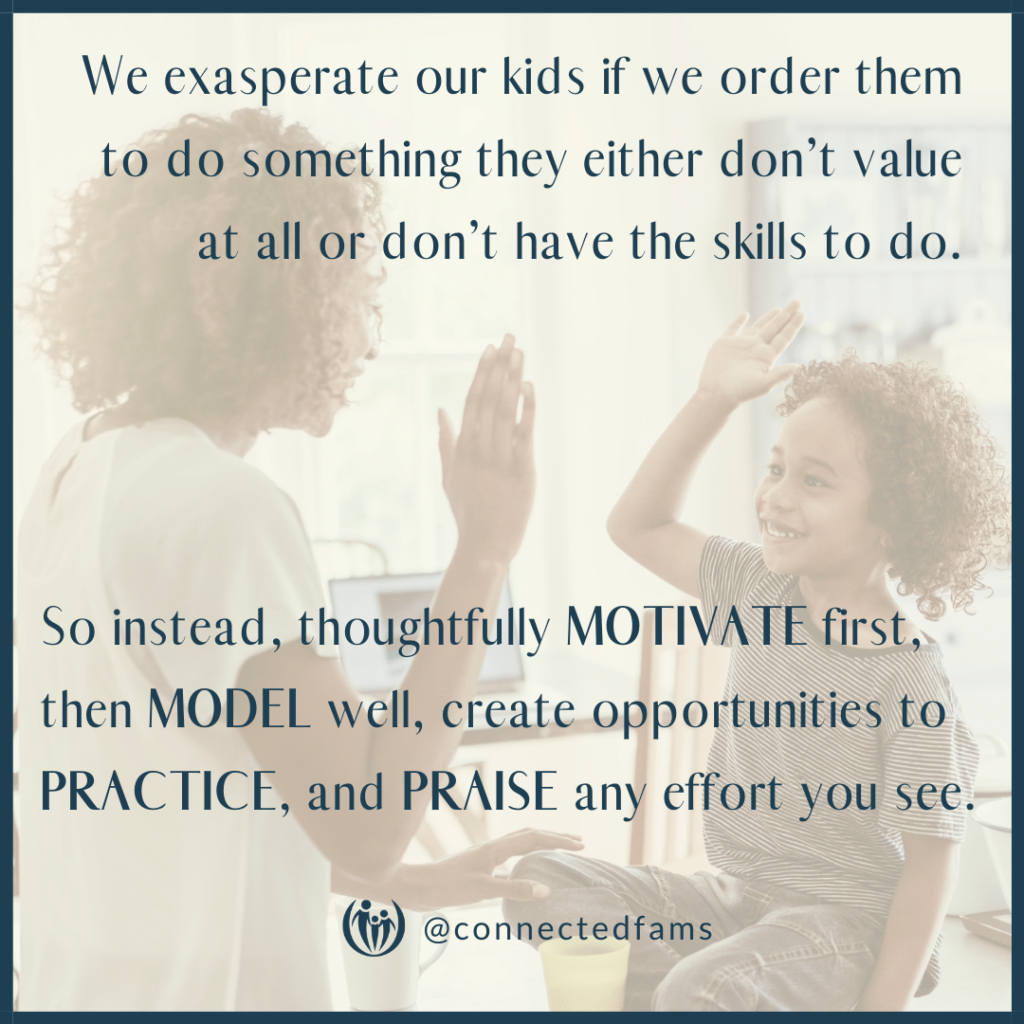
4 Steps to Change Your Child’s Behavior

Ever tried to change your child’s behavior? Or, how many times in the last hour have you actually tried to change your child’s behavior?
If you’re like most parents, too often our methods go something like, “Uhhh! If I’ve told you once, I’ve told you a thousand times, that is NOT OK!! Why do you keep…hitting your sibling/sassing me/making a big mess?” And then, ”You need to…take a time out/apologize/clean this up!”
Reality check: you can’t change another person’s behavior – only yours.
Ready to stop reading? I promise this is not a bait-and-switch article. Your child’s behavior can change.
What if you could motivate your child to change their behavior the way a good boss motivates you to change your own performance? Better yet, what if this method looked a lot like how Jesus discipled his followers?
Let’s dive in.
One of the most frequent pitfalls busy parents experience is to wait until after a child’s bad behavior to try to manage it with angry commands, consequences, or lectures. It’s a frustrating cycle that builds discouragement, frustration, and resentment in both parents and kids.
Imagine how frustrating it would be if your boss demanded you do something you thought was difficult and utterly useless. And, if you didn’t do it according to his or her standards, got upset, or threatened to dock your pay.
Similarly, if parents make a demand and then try to motivate through a threatened consequence, it’s a setup for frustration for all. We exasperate our kids if we order them to do something that they don’t value (and/or don’t have the skills to do) and then punish their failure.
Start changing this pattern by identifying one or two values or skills your child struggles with that you’d like to encourage. Examples might be flexibility, cooperation, serving, peaceful waiting, respectful anger, etc.
Change your child’s behavior using “MMPP”
Rather than threatening a consequence, keep those values and skills in mind as you try this sequence: Motivate, Model, Practice, Praise.
- Proactively motivate first
- Model the value or skill yourself
- Help your child practice
- Then effectively affirm (“praise”) whatever goes well.
In this article, I’ll give practical examples of what it might look like to live this out in your own family. I’ll also show how Jesus’ strategy for sending out 72 of his followers loosely follows this model. He equipped them with the confidence and skills to do ministry on their own. (Luke 10:1-23)
Here are some examples for each of these principles.
Motivate
You may have found yourself on auto-repeat trying to teach kids skills they don’t want to learn. Conversely, you might have a child that, when locked on to something that is important to them, they are unstoppable!! They’ll figure it out, learn the skills, bulldoze the obstacles, and get ‘er done.
This all testifies to the essential nature of motivation before trying to teach kids anything! If you’re hoping to help your child with a change in behavior, the best place to start is with the child’s motivation. How do they value the importance of the behavior? (For example, a child with no intrinsic value in expressing gratitude is going to be on a very slow learning curve to remember to thank Grandma for the Christmas present.)
Once your child values the task or skill at hand, the rest often follows almost effortlessly on your part.
Here are some practical ideas to choose from as you venture into the arena of motivating your kids.
- Discuss the natural benefit/impact of the character trait or skill you’d like to encourage.
- What story or analogy could you use to explain the value of the trait or skill?
- How could you use books/TV, or other media to spark a discussion?
- Share a scripture that applies in a positive, non-shaming, even fun way (i.e., Proverbs has lots of fun verses to build wisdom and motivation.)
- Discuss “What would happen if….” scenarios …if Mom or Dad could never wait peacefully?
….if everyone in the world knew how to be respectfully angry? Discuss, or role-play, and have fun! - Remind kids of previous success. It’s a strong motivator. Be thoughtful about times they have done well with this trait/skill in the past or any growth you notice. Express confidence in them.
Throughout Jesus’ ministry, He motivated His disciples with analogies and parables that taught the value of the kingdom of God and the value of each individual to God. Then just before He sent them out, He encouraged them with the prospect of success: a rich harvest of ministry. (Luke 10:2)
Ask yourself: What is my plan to build motivation in my child?

Model
Most of us don’t consciously practice a “Do as I say, not as I do” approach with our kids, but we often do just that. While you likely wouldn’t call your child a bad name, you may still inadvertently use shame to manipulate their behavior. It’s all a form of disrespect. Unfortunately, your child’s behavior won’t likely change if they see you doing what you’re trying to get them to stop doing. (Even if in your mind it’s a “shinier”, more acceptable, adult version.)
Our goal, as parents, should be to confidently say what Paul says in Philippians: “Whatever you have learned or received or heard from me, or seen in me—put it into practice.” Philippians 4:9
- Share stories about the ups and downs during your childhood as you learned important values and skills, including the natural impact of both your successes and failures.
- Tell kids what character trait you are currently working on. (This could be the same or different from what you want to encourage in them.) Overtly celebrate when you have success, so kids associate positive feelings with working on traits and skills. Build a family culture that values learning and is okay with mistakes.
- As you model, talk about your process. This is especially important for the character traits you want to encourage in them. For example, with flexibility: “This is really frustrating that the rain wrecked our picnic plans. But I’m going to be flexible, take some deep breaths, and write a list of three fun things we could do instead.”
Jesus modeled a lot! From Luke 4:14 to the sending out of the 72 disciples in Luke 10, Jesus teaches, heals, raises the dead, casts out demons, and does miracles of nature. During this time, His apostles and the larger group of disciples watched and sometimes assisted (Luke 9:13-17).
Ask yourself: What is my plan to model a particular trait or skill and even draw my child’s attention to my modeling? “I’m working on stepping back and taking a breath when I get upset. That was really helpful this time and I’m glad I remembered to do that!”
Practice
Consider a mentor or coach who had a very positive impact on your life. How did they help you learn values and skills that were difficult for you?
My guess is you practiced. A lot. It’s vital to thoughtfully build skills outside the stress of the moment. These skills can then transfer to pressure situations. Just like our own development, this consistent practice helps kids’ brains make new pathways for helpful values and skills as they learn.
- Role-play a trait or /skill. For example, if you are trying to teach gracious losing, have the child practice/pretend losing a game and blow up (you can even make it a little silly pretend tantrum!). Then repeat but have them pretend to lose a game and respond graciously. Discuss how each version makes your child feel and affirm their success.
- Make sure the task is a “just right challenge” for your child. This means that the task is a challenge but they have a good shot at succeeding.
- Work with kids at first, making practicing these skills fun, even silly, sometimes.
- Provide visual cues as needed to help guide their process. Some examples might be a picture schedule of morning routine, photos of calming choices, a poster of the steps to conflict resolution.
- Offer “do-overs” in a light-hearted way when kids struggle. Make sure you have modeled this often before you ever invite your child to do them!! And if they are upset, wait until they’ve calmed down. This gives them a second chance to practice a wise response.
Jesus had his disciples minister with him extensively (John 6:1-13), and then when He sent them out he gave very clear instructions about how to do exactly what He was asking. It was a just-right-challenge of teaching in homes …not taking on the Pharisees in the synagogues! But He warned them it still would not always be easy. (Luke 10:4-11) He also offered a grand “do-over” after Peter denied Christ three times. (John 21:15-19)
Ask yourself: What does my child need to successfully practice this trait or skill?
Praise
Praise is the last step. It’s where our “focus is fertilizer.” (I prefer the word affirm, but it misses the nice alliteration of Motivate, Model, Practice, Praise. 😉 In 1 Thessalonians 2:11-12 Paul models and describes wise, faith-filled parenting: “For you know that we dealt with each of you as a father deals with his own children, encouraging, comforting, and urging you to live lives worthy of God, who calls you into his kingdom and glory.”
So keep an eye out for whatever is going well, and encourage kids’ effort as you build values and skills. If they fail, comfort them and urge them to persevere to learn and grow in God’s purposes for their lives. Our final set of practical ideas will equip you for truly effective affirmation:
- Help children feel good about the natural impact of their actions. Instead of “Good job! I’m so proud of you,” which makes the praise all about your feelings, use the “ABCs of Affirmation” (Action–Benefit-Character) approach. This will effectively affirm kids, and you can guide them to discover the Action–Benefit-Character of their value/skill on their own by asking thoughtful questions.
- Praise God as the source of all good growth with a statement as simple as “I love how God is helping all of us to grow in respect toward each other.” You can also share these verses with your kids:
“Every good and perfect gift is from above…” (James 1:17)
“We love because he first loved us.” (1 John 4:19)
Jesus celebrated as he described the impact of his disciples’ work (Luke 10:18) and encouraged them in their ability to continue to minister in this way (Luke 10:19). Perhaps most importantly – Jesus told His disciples that they were loved unrelated to their accomplishments, and that should be the source of their joy (Luke 10:20) He gave credit where it was due: He praised the Father that He had chosen to work through His children in this way. (Luke 10:21)
Ask yourself: How can I use the ABCs of affirmation (Action, Benefit, Character) to grow this particular trait or skill when I see it in my child?
In conclusion…
This approach may not come naturally. It might even seem easier to command, threaten, and bribe. This approach requires that we take a step back and listen to the Holy Spirit guide our steps. When we motivate, model, help kids practice, and then praise their efforts, we encourage kids’ hearts and build important values and skills into their lives. And we follow the example of Jesus that He regularly demonstrated with His disciples!
*This model of training kids is adapted from Mark Holman’s Faith at Home training of parents.
What are your parenting strengths?
You’ve got them. Knowing your strengths will help you become the best parent you can be. Knowing your parenting challenges is useful information too. Take our FREE ASSESSMENT.






